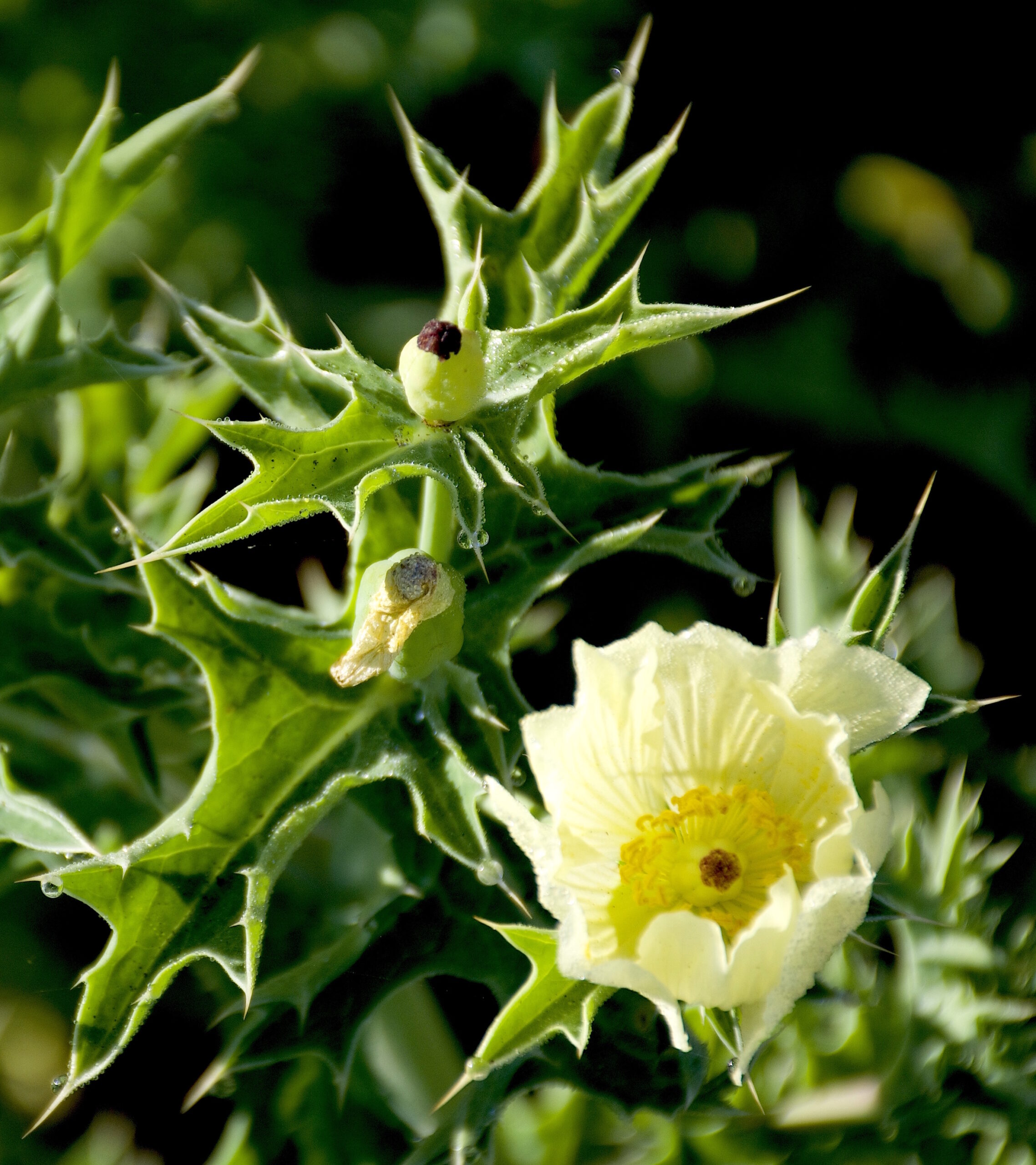
Toxic Mexican Poppy photo by Green Deane

White mexican poppy.
No, it is not edible. This time of year you will see yellow Mexican poppy Argemone mexicana in dry areas. Beside railroad tracks is a common location. If the blossom is white it is argemone albiflora, see photo at right. The plants are poisonous — particularly the seeds — but have been used medicinally. The toxic seed oil has been used to adulterate commercial “vegetable” oil, particularly mustard seed oil (to make it more peppery.) And added to tea and beer for the same effect. The oil however has been used for soap making and fuel. In folk medicine the Mexian Poppy has been used to treat asthma, the root mixed with rum for stomach pains, the stem sap for toothaches and petals given to kids with various urination problems. The seed oil also has been used to treat leprosy, skin diseases, indolent ulcers, injuries, flatulence, constipation, colic, malaria and rheumatalgia. Extracts reduce morphine toxicity. Research suggests they might be good for treating liver disease. Alcohol extracts are anti-bacterial particularly against Staphylococcus aureus and Bacillus subtilis, Escherichia coli and Pseudomonas aeruginosa. Argemone is from ancient Greek and means “cataract of the eye” as the ancients believed it would get rid of cataracts. Where the plants are prolific they are a common allergen.
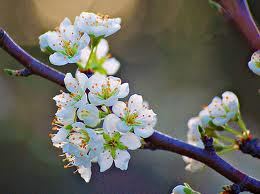
CHickasaw plum blossoms photo by Green Deane
This time of year it is easy to spot the Chickasaw plum, the Eastern Red bud and the Pink Tabebula. They all have many blossoms and few leaves. The chickasaw plum (prunus angustifolia) will have edible fruit near the end of spring, the Eastern Red Bud (cercis canadensis) has small pink blossoms you can eat now and later pea pods, the Pink Tabebulia (Tabebulia heterophylla.) is mostly just pretty though a tonic/tea used to be made from the cambium. In folk medicine it was used as an anti-inflammatory, antimicrobial and for treating cancer
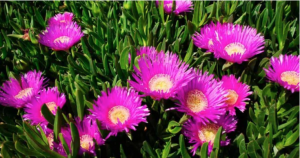
Ice Plant is native to South Africa.
Natives in northwest United States had a saying: When the tide is out the table is set. I use a variation in my foraging classes: Food is where the water is. Foraging is treasure hunting for adults. An unusual edible you can see from Port Charlotte to Tarpon Springs is Carpobrotus edulis, the ice plant You can find it on the land side of Fred Howard Park, Tarpon Springs and at the Nature Park in Punta Gorda. Ice Plant resembles purslane on steroids. Definitely not native, it’s a succulent-looking ground cover often put into coastal landscape. Leaves are less than two-inches long, opposite, evergreen, lance shaped. The plant gets to about a foot high and is drought tolerant. The pink blossom with a yellow center is cactus-like. Leaves are used in salads. Fruits are eaten raw, dried, cooked or pickled or used in chutneys and preserves. Also edible are C. aequilaterus and C. deliciosus.
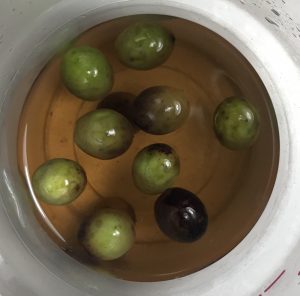
Beginning brining Osmanthus megacarpus
There are can be many reasons why an edible wild plant is not eaten. Often they were replaced by a better cultivated crop, or they were eaten in other parts of the world but not locally. Sometimes one group ate it but their rivals did not, or one group only ate the seeds and another group only the roots. And sometimes the information was not shared leaving the plant in modern foraging limbo. Foresteria are in the olive family. As far as I know locals only used the fruit of one, F legustrina, and then to make ink. The fruit is bitter, but so, too, is the common olive without brining. Two Foresteria, F. neo-mexicana and F. pubescens var. pubescens, were eaten raw. A native member of the olive group is Osmanthus megacarpus a.k.a. cartrema floidanum. Which I have eaten after brining and I know a person who eats them before brining.
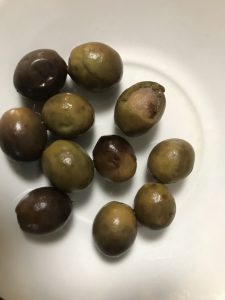
After brining a month in four changes of brine.
Brining means soaking the fruit covered in salted water (in this case submerged in a 10% solution) for a month and changing it every week essentially the same processed as fermenting. Salt is often used to reduce tannins and is part of the process of turning Java Plums into wine. One critical element when fermenting or brining is the material you are treating has to be submerged. If any part is out of the liquid it will grow mold. I used a glass plug/plate to keep this fruit in the solution. After a month of brining the fruit had lost its bitterness and had an acceptable taste. The seed is most of the fruit leaving little pulp to eat. It was a lot of attention and time for a small amount of payoff. Then again we don’t eat a lot of plants for their caloric punch. As the forager Ray Mears has often said every little bit fills the soup pot or the tummy. These did taste like cured olives. In a previous newsletter I wrongly called the Osmanthus a Forresteria (whose berries tend to be small, oblong, and often blue/black.
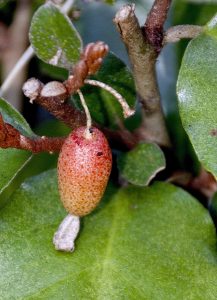
Silverthorn berries ripen around St. Valentine’s Day. Photo by Green Deane
Valentine’s Day was this week which reminds us of Silverthorn. Silverthorn usually fruits around Valentine’s Day. We’ve been seeing ripening berries for several weeks and found a lot of sweet ones this past weekend. Locally it is a very common hedge plant that is rather easy to identify. It has green waxy leaves that are silver on the back with rusty freckles. The fruit is about the size of a jelly bean and light red with silver and gold sprinkling. You can read about it here, and a video here. Also flowering this week and will be fruiting soon is Eastern Gamagrass. A clumping ornamental (and native) it has a frilly flower spike that turns into grains that can be used like wheat if you can get them out of their husk. You can read about it here.

Foraging classes are held rain or shine, heat or cold. Photo by Nermina Krenata
Foraging Classes: Sticking to the southeast end of the state this weekend, with a class in Ft. Pierce and then West Palm Beach, the latter is more tended to than the former.
Saturday February 18th, La strange Preserve, Ft. Pierce, 9 a.m. meet at the parking lot.
Sunday February 19th, Dreher Park, West Palm Beach, 9 a.m. meet north of the science center parking lot.
Saturday February 25th, John Chestnut County Park: 2200 East Lake Road, Palm Harbor, FL 34685. Meet at the trail head of the Peggy Park Nature Walk, pavilion 1 parking lot. 9 a.m
Sunday February 26th, Wickham Park: 2500 Parkway Drive, Melbourne, FL 32935-2335. Meet at the “dog park” inside the park 9 a.m
For more information, to pre-pay or sign up, go here.

You get the USB, not the key.
My nine-DVD set of 135 videos has been phased out and replaced by 171-videos on a 128-GB USB, see right. The USB videos are the same videos I have on You Tube. Some people like to have their own copy especially if social order falters. The USB videos have to be copied to your computer to play. If you want to order the USB go to the DVD/USB order button on the top right of this page or click here. That will take you to an order form. Or you can make a $99 donation, which tells me it is for the USB (include a snail-mail address.) I’d like to thank all of you who ordered the DVD set over the years which required me to burn over 5,000 DVDs individually. I had to stop making them as few programs now will read the ISO files to copy them. Burning a set also took about three hours.

Green Deane Forum
Want to identify a plant? Perhaps you’re looking for a foraging reference? You might have a UFO, an Unidentified Flowering Object, you want identified. On the Green Deane Forum we — including Green Deane and others from around the world — chat about foraging all year. And it’s not just about warm-weather plants or just North American flora. Many nations share common weeds so there’s a lot to talk about. There’s also more than weeds. The reference section has information for foraging around the world. There are also articles on food preservation, and forgotten skills from making bows to fermenting food. Recent topics include: Stale Bread and Cod Liver Oil, Killing Bugs with Tobacco Plugs, Eating weeds: Is it safe? Have they mutated? Not the Eastern Red Bug but the Pink Tabebuia, African Tulip Tree, Asparagus densiflorus, Green Deane’s Book… You can join the forum by clicking on the button on the upper right hand side of this page.
This is my weekly newsletter #545. If you want to subscribe to this free newsletter you can find the sign-up form in the menu at the top of the page. My website, EatTheWeeds.com, which is data secure, has over 1500 plants on it in some 428 articles. I wrote every one myself, no cut and paste.
To donate to the Green Deane Newsletter click here.

